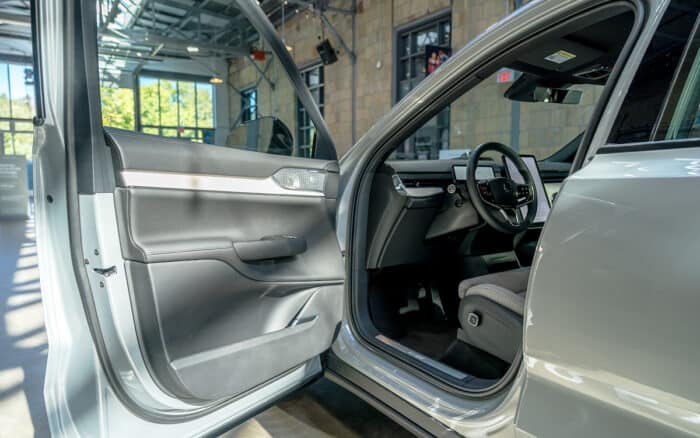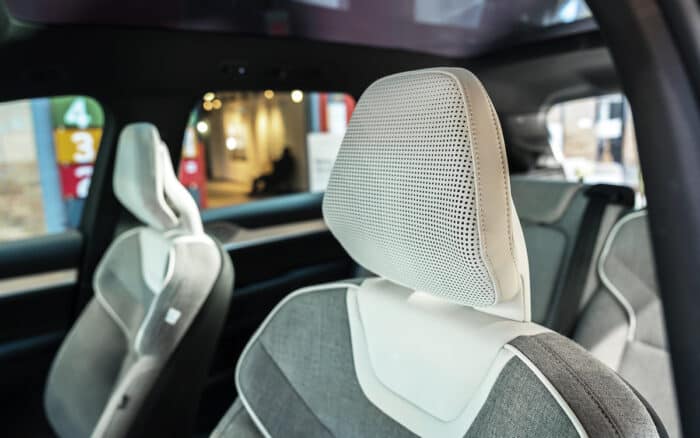The 2025 Volvo EX90 brings a seven-seat SUV to the brand’s EV lineup, and despite manufacturing delays, orders are set to be ready for the summer of 2024. Media got to see one and get closer to the design choices that could make it stand out.
The EX90 takes more than a few cues from the XC40 Recharge, which it effectively supplants as Volvo’s flagship SUV — at least as a complement to the combustion engine XC90. There is a reference point between the two, given the XC90’s popularity as a full-sized SUV, and it shows in how Volvo tried to make room for new technology inside the EX90.
Seven-seater, all-electric SUV pushing 500 horsepower

For starters, Volvo built the vehicle on its Scalable Product Architecture (SPA2) to enable a broader sense of space. It has a dual motor powertrain for all-wheel drive performance capable of hitting 496 horsepower and 671 lb-ft. of torque.
The 111kWh battery is boastful in the right ways, meaning it can theoretically handle charge rates as high as 250kWh, which would translate to a 0-80% charge in 30 minutes under an ideal scenario. Volvo estimates range to be roughly 300 miles or 534 km.
Cameras, radars, and lidar connected to the EX90 SUV’s core computers
Much of all that is unseen from the outside, where the EX90 maintains the minimalistic approach Volvo has favoured for a long time, save for the snazzy Thor’s hammer headlights. The vehicle’s safety features include built-in sensors, plus cameras and radar detection to spot hazards or pedestrians on the road.


They’re all joined by a LiDAR system that promises to be even more precise when its lasers find those things on the road from further away. The LiDAR is set up top above the windshield, positioning it at a higher elevation to “see” everything all around at 360 degrees and assist the other safety tech onboard.
Meanwhile, infrared cameras inside the vehicle face the driver to look out for eye movement in case of driver fatigue. It’s designed to work like the system Volvo implemented in the EX30, where it will sound an audible alert when a driver is unresponsive, and then slow the vehicle down or pull over somewhere, come to a full stop, and put the hazard lights on.
Ride Pilot, a semi-autonomous driving mode
This fits right in with the intention of using Ride Pilot, a semi-autonomous driving mode (even if Volvo won’t use the term) allowing the EX90 to drive itself on highways. What’s not yet clear is availability because the company initially said it wanted to offer it as a subscription-based add-on, starting in California first.

Volvo even thought of including an in-car radar system that alerts drivers when they lock the vehicle with a pet or child still inside. Unlike the EX30, however, there is a small digital instrument cluster behind the steering wheel, leaving some information and features for that screen instead of the larger 15-inch infotainment display in the middle.
Since the cluster screen is part of the steering wheel, it moves as you adjust the wheel itself, presumably giving you a clearer view of it at all times. The larger screen runs Android Automotive with direct integration for Google Maps and Assistant on both displays when you use them.
Sign in to apps and download others directly from the Google Play Store on the screen itself. If you want a projection platform, Apple CarPlay and Android Auto will also work. You’ll have to get used to that because there are no buttons or knobs at all. Other than ports to plug in to charge, the EX90 otherwise keeps physical elements to a bare minimum.
Spacious interior with responsibly sourced materials

There was no way to test out any of the tech and safety features, nor could anyone actually sit inside, but it was easy to get a sense of what the EX90 was like inside. The interior is spacious all around, with ample room to seat a larger family. The trunk gives you 365 litres of space, which you can extend significantly to 1,010 litres when folding both rear seats down (one or both), creating even more expansive rear storage.
Interior fabrics come from recycled materials, like the Nordico mix of PET bottles, cork and bio-attributed material with pine oil harvested from forests in Sweden and Finland. The headrests definitely sport this leathery material that helps give the EX90 some luxury on the inside.
Volvo says it will offer a wood blend finish as an option — repurposed wood, of course — as an alternative. All told, the company claims there are 50 kilograms (110 pounds) of recycled plastics and bio-based materials in each EX90 set to come off the assembly line.
As with the EX30, customers can choose from various “rooms”, Volvo’s term for interior finishes. Each one will consist of some mixture of recycled or natural materials in keeping with the company’s vision toward sustainability.

The EX90 has been marred by delays, the latest of which pushes production back by five or six months, largely to complete the new software, so deliveries for existing orders would be in the summer of 2024 at the very earliest.
New Volvo EX90 expected price, preliminary specs, and images
Volvo has yet to confirm what the 2025 EX90 will cost, but an $80,000 USD ballpark is the rumoured possibility. If that’s true, it means the EX90 wouldn’t qualify for the U.S. federal EV tax credit because it wouldn’t meet the requirements for stateside sourcing and manufacturing to make it eligible. Meantime, here are some 2024 electric SUVs worth checking out.
| Electric range | 300 miles, 534 km |
| Charging time (fast charge 10-80%) | 30 minutes |
| Battery capacity | 111 kWh |
| Horsepower | 496-hp |
| 0-60 mph | 4.7 seconds |
| Width | 77.3 in |
| Height | 68.7 in |
| Length | 198.3 in |
| Cargo capacity | up to 67.6 cu ft |
| Towing capacity | 4,850 lbs |


